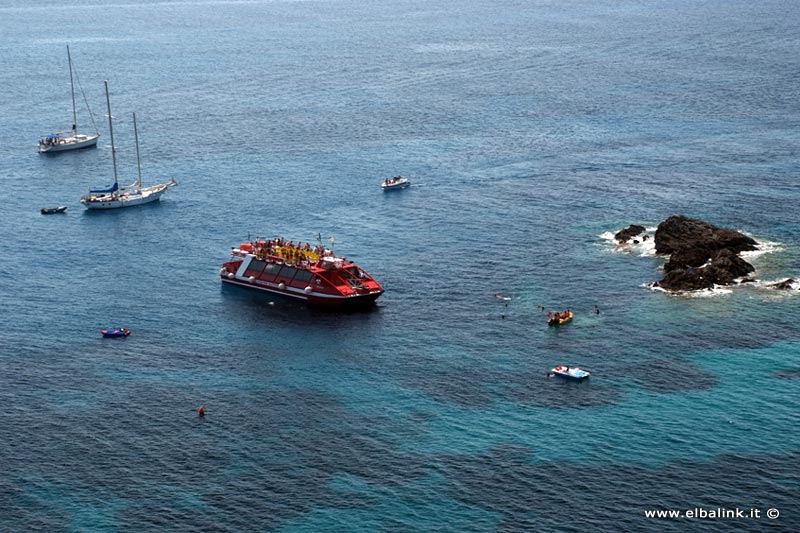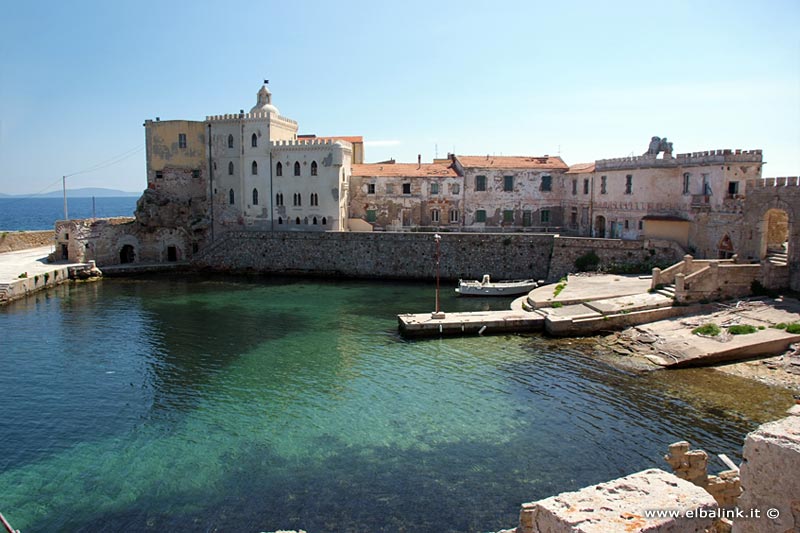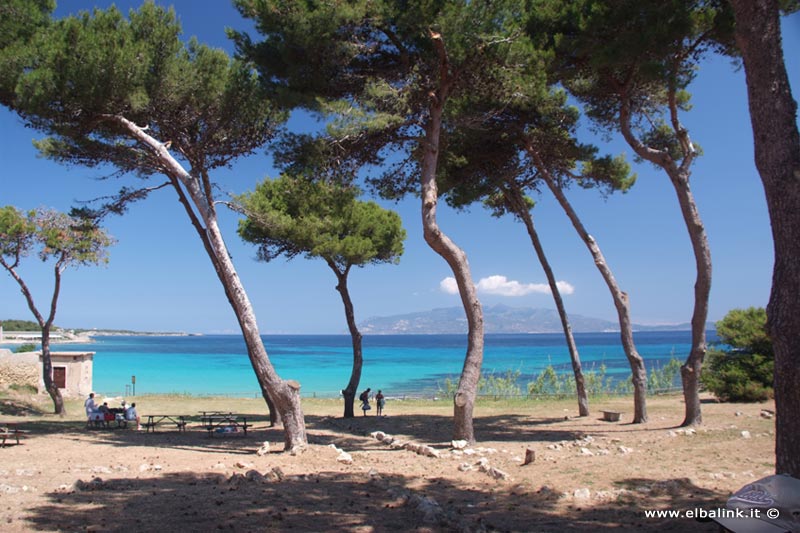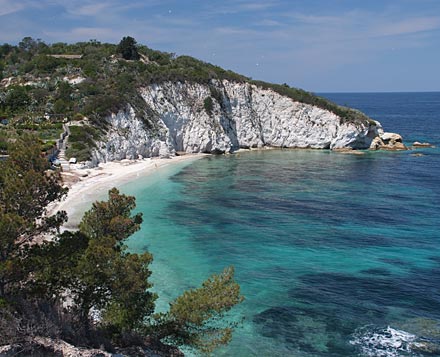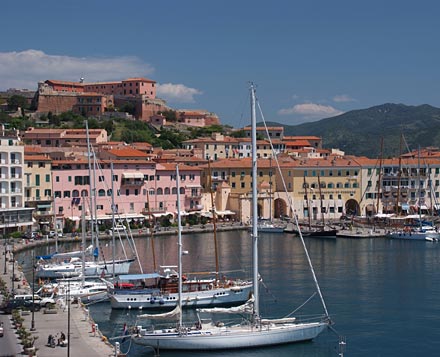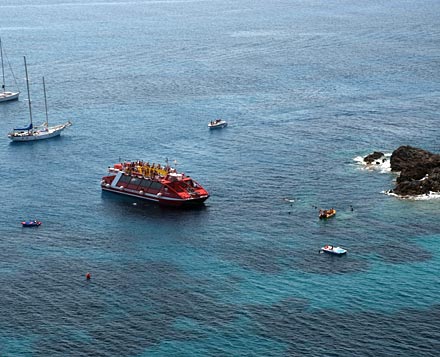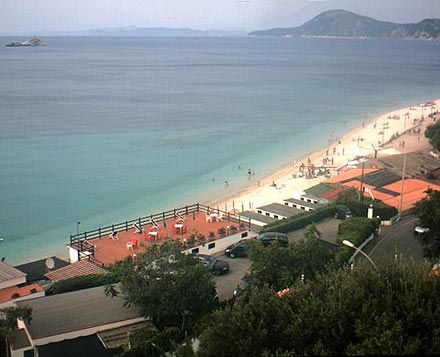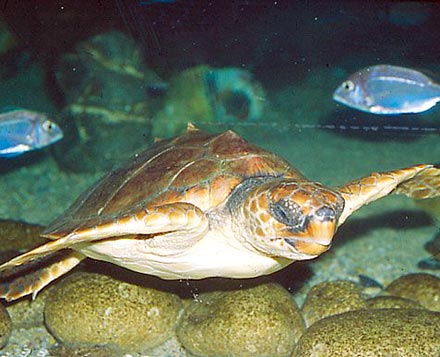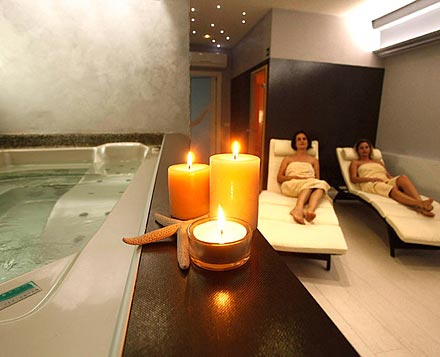Trips around Elba and the Tuscan Archipelago
BOAT TRIPS
THE BOAT "NAUTILUS"
Take a trip on the "Nautilus", the newest way for people to sail, the biggest of its kind - 24x8 metres - in the Mediterranean, that can carry from 200 to 240 passengers. On board you can admire the breathtaking coastline of the Island of Elba; inside, thanks to the glass bottom measuring 80 metres2, you can admire the flora and fauna on the completely natural sea bed.
The boat sails from both Marciana Marina and Portoferraio:
- The trip from Marciana Marina takes you as far as the coast of Pomonte, where you can see the wreck of a merchant ship that sank in 1972, all explained on a registration in Italian.
- On the other hand, the trip from Portoferraio takes you along the coastline of Enfola promontory as far as Golfo del Viticcio, where you can admire the sea bed of the magnificent "Secche di Capo Bianco" marine reserve.
Not only is the Nautilus fully equipped with every possible comfort - air conditioning, stereo, and bar - it also has the latest navigational instruments so you can be sure of a safe and truly relaxing trip. Passengers have access to a panorama deck, a covered deck and the room at the bottom to view the sea bed.
THE "BELUO" SHIP
Trips to the Islands of Pianosa, Capraia, Giglio and Montecristo.
PIANOSA
Pianosa is the fifth largest of the seven islands in the Tuscan Archipelago, and lies 13 km south west (SW) of the Island of Elba. It has an area of 10.3 square kilometers and a coast line of about 18 km.
Today, the Island of Pianosa is more or less deserted, with but a handful of people who actually live there. (some policemen, the family of one of the prison guards of the former prison, and two or three day release prisoners).
The island is so called ("Planasia" was its original name in the past) because it is almost completely flat with only a slight elevation in some places. The highest elevated area is a mere 29 metres, while the average height above sea level is about 15 - 20 m.
The entire Island of Pianosa is part of the Tuscan Archipelago National Park. It is forbidden by law to fish and/or sail within a one mile radius of the island. Access to the island is subject to a special license issued by the Park Management.
The island is part of the Commune of Campo nell'Elba, in the province of Livorno.
Pianosa used to be a penitentiary and a penal colony. In 1858, the "agricultural penal colony of Pianosa" was established,and prisoners who were convicted to "a prison sentence, forced labor and life sentences" were sent to the island, all destined to work in the fields. In 1861, when the Unification of Italy was declared, the number of prisoners had reached 149. In the following year, the construction of a building meant to house 350 prisoners was completed, but in 1872, the decision was made to divide the island into several small agricultural production centers, so-called "poderi", and as a result the prisoners were split up into small communities.
Around 1880, there were close to 960 prisoners confined to the prison on the island. From 1884 onwards, prisoners from prisons all across Italy, who had come down with tuberculosis, were moved to Pianosa, thus joining those already inhabiting the island, and stayed there until 1965. The treatment of patients with tuberculosis was carried out in three separate structures: Preventative (today Centrale), where patients thought to have tuberculosis underwent the initial tests; the sanatorium (ex Podere del Cardon, today Agrippa), a well equipped hospital for the treatment of lung diseases; the convalescence home (Podere del Marchese), where prisoners who had overcome the illness were sent for a convalescence period.
Even Sandro Pertini, the then future president of Italy, who had been arrested in 1932 for political reasons, was for some time a "guest" in the Sembolello department. In those days, the time when the highest number of civilians lived there, there were all in all about 60 families. In the 1980s, from various sides a debate was held to close down the prison once and for all and return Pianosa to the competent civil authority.
However, as a result of the critical political situation that raged after the assassination of the judges Falcone and Borsellino, the government decided to immediately reopen the high-security prison on the island and banished prisoners convicted of mafia crimes to the institution. These new circumstances made Pianosa more like a fortress, with the Agrippa department separated from the rest of the island and access denied to anyone. Correction officers, guards and police officers watched over Pianosa day and night, and very strict bans came into force forbidding aircrafts from flying over the island and ships sailing in the nearby waters.
The state of emergency continued until July 1997 when the last Mafia prisoner left the island and was sent to a different prison on the Italian mainland. Once again, there was a debate about closing the prison on Pianosa for good. It was more or less completely closed in August 1998, with only a handful of wardens left on the island with the sole task of supervising and watching over the complex.
A trip to Pianosa (with a stay of approximately 6 hours) gives you the chance to:
DO NATURE TREKKING - TOUR THE ISLAND BY BIKE AND/OR HORSE AND CARRIAGE AND/OR BUS.
During the trip you will also visit the Christian catacombs, the Roman spa resort that was owned by the nobleman Marco Postumo Agrippa, and the photo exhibition entitled "Coalition for the Protection of Pianosa", from the Stone Age to the settlements of the first of Italy's agricultural prison colonies in the 19th century.
CAPRAIA
The history of the Island of Capraia Island is truly exciting and fascinating. The first settlers - Phoenicians, followed by Greeks, Etruscans and Romans - arrived towards the end of the III century BC.
It became home to an intensive religious reality when Christianity began to spread across Rome, and several groups of monks fled to the island to escape from the Imperial repressions after the Edict of Milan in 313 AD. For centuries, the island had been invaded by pirates, so fortresses were built there first during the Roman Empire, then the Republic of Pisa and finally the Banco di San Giorgio. These fortresses can still be seen today (for example the Fortress of San Giorgio bearing the same name as well as the many defense towers along the coast). This part of Capraia's history is without a doubt the most fascinating: due to its highly strategic position, Saracen pirates, wars, and continual territorial questions all forced Capraia to be in the front line at one time or another.
After almost seven centuries of continual conquests and wars, Capraia fell first under Corsica, then the Republic of Genoa, then Pisa, then France and finally even England until, after the defeat of Napoleon, the Congress of Vienna decided to hand it over to the Kingdom of Sardinia. And this was when the famous State Tobacco Agency was established, but 70 years later, a Penal Colony set up by the Kingdom of Italy and used as a place where people were "banished" during Fascism took its place.
During the two World Wars, Capraia once again played an important, adventurous part in its history, rich in stories and anecdotes, but also became home to soldiers killed at war and patriots. The penal colony was finally closed down for good in 1986 by ministerial order. In 1989 the island became part of the Tuscan Archipelago National Park.
Capraia Island is part of the Tuscan Archipelago National Park, a nature reserve of about 18000 hectares of land and 60000 hectares of marine surface. It isn't difficult to see why a national park that includes both land as well as sea was established: the crystal clear water, as yet untouched by man and pollution free; the different types of sea bed and coastal areas of each island; and last but not least the numerous tiny pieces of land that rise up from the sea make this area the perfect biological habitat for both permanent and migrating marine fauna.
Besides this, Capraia is the only island in the Archipelago to have a natural fresh water lake and the fact that it is in one of the most important "faunistic migration corridors" between Africa and Europe, makes it both a resting and a reproduction place for a wide variety of species of birds. Capraia also has a significant number of both vegetable and animal endemisms. Due to being also in the heart of the so-called "whale pilgrimage area", groups of dolphins and whales are often seen here. All this therefore makes this small island a natural paradise not far from busy cities, an unexpected oasis of wild and fascinating natural treasures that are most definitely worth a visit.
A trip to Capraia (with a stay of about 5 hours) gives you the chance to:
DO NATURE TREKKING - DO KAYAKING - GO SNORKELLING
ISOLA DEL GIGLIO
THE ISLAND OF GIGLIO The Island of Giglio (Province of Grosseto) is a small commune with a population of a little more than 1500 living on the island bearing the same name, in the Tuscan Archipelago (Tyrrhenian Sea), about 16 km from Monte Argentario.
The ferries that connect the island to the mainland belong to the Maregiglio and the Toremar shipping companies, and sail to and from Porto Santo Stefano. During the summer months, there is a small, formality fee to be paid if you wish to take your car over to the island.
Giglio Porto is on the east coast of the island and is where boats and ferries coming from the mainland in Tuscany dock.
In the past, the actual village, built around the port, and consisting merely of the fishermen's houses, and offers a beautiful promenade and picturesque alleys that lead to the beautiful Piazza della Dogana,what could be considered the "living room" of the island. The Saracen Tower dating back to the Middle Ages and the Church of the Madonna del Giglio are two historical buildings that are well worth a visit.
Giglio Castello, the Medieval town, is in the higher, more central part of the island, and is characterized by the enormous Aldobrandeschi style Rock, part of the castle complex, as well as the typical city walls that are still in good condition, and several defense towers.
There are also two churches in the Medieval town, one dedicated to Saint George and the other to Saint Peter, and in the latter the "treasure" of Pope Innocenzo XIII as well as a magnificent ivory, crucifix, a masterpiece by Giambologna, are safely kept.
Giglio Campese is a modern tourist resort on the west coast of the island opposite a wide beach sheltered by a bay, the southern tip of which borders a row of picturesque cliffs; the northern part,on the other hand, comes to an end with the Torre del Campese, a tower that dates back to the 14th century. There is a tourist port for smaller boats near the watch tower.
The island has been inhabited since the Iron Age. In later days it became a military base for the Etruscans and even under Roman rule it was a somewhat important military base in the Tyrrhenian Sea, which was mentioned for example both by Julius Caesar in De Bello Gallico and by the poet Claudio Rutilio Namaziano. Just off the houses in Giglio Porto, slightly below sea level, you can see what is left of the Roman Domizi Enobarbi villa: a large area consisting of a sea tank with a fish farm, the outer walls and covered colonnades, what remains of the Opus Sectile, mosaics, frescos, a star shaped terrace, buildings located on the seashore with arcades and a long, hanging patio. The entire area is called "The Castellari of Giglio Porto".
During the eras that followed, the island was ruled by various different families of noblemen from central Italy, and after 1264 by the government of the city of Pisa, which eventually lost the island to the Medici family. During the Middle Ages, it came under the rule of the Aldobrandeschi family, and then became a part of the commune of Perugia. From 1264 until 1406 it belonged to Pisa, then later to Florence.
Not far from the Roman remains, a medieval tower raises high, the so-called "Saracen Tower", and at the end of the beach of Giglio Campese you can see the defense tower, Torre del Campese, which in the late Middle Ages was built to protect the island from Saracen invasions. It has since been renovated and is now a privately owned residence. In 1544, the famous pirate Khayr al-Din, known as Barbarossa, plundered the island, killing anyone who got in his way, and deported 700 residents as slaves. After this bloody raid, the Medici family settled people from the Siena area onto the island. The Saracen attacks lasted until 1799.
In the centre of Giglio Castello, not by chance in a very significant place, is the Medicean Rock, which has just recently been renovated. In the church of San Pietro the Apostle, in Giglio Castello, you will find an ivory crucifix attributed to Giambologna.
A trip to Giglio island (with a stay of approximately 4 hours) gives you the chance to: GO SNORKELLING
MONTECRISTO
The Island of Montecristo is in the Tyrrhenian Sea and is part of the Tuscan Archipelago. As far as administrative government is concerned, it is under the commune of Portoferraio and thus the province of Livorno. It is both a State Nature Reserve and part of the Tuscan Archipelago National Park. The island has always been uninhabited, and today, the only permanent residents are two lighthouse guards and some forest rangers, who swap over each week.
The conditions which have not allowed the island to be inhabited have on the other hand enabled the flora and fauna to thrive. Here, many animal and plant species that at one time could be found throughout the entire Mediterranean region, today are able to live and prosper only here: the Montecristo viper (a unique species found only on this island), and the Sardinian discoglossid, an amphibious creature that today only lives on this island or in Sardinia. Furthermore, the island is a popular resting spot for thousands of migratory birds. Even the marine life is very rich: carpets of Posidonia, sea anemones, gorgonia and corals, even moon fish and monk seals have been seen here.
Montecristo is the most remote and wildest of all of the Tuscan islands. Attempts to populate the island go as far back as the age of the Etruscans and continue into more recent times, when, after the unification of Italy, attempts were made to set up a penal colony here. Unfortunately, because of its distance from the mainland, the island's remoteness, the adversity of the soil as well as the difficulties in actually reaching the island, every attempt has failed.
These adverse conditions however have given birth to countless mysterious legends over the centuries, like the numerous ghostly presences on the island because of which it would be impossible for people to survive, or that which portrays the island as the secret hiding place of the Saracen pirates' treasures. Several crucial scenes of the famous novel "The Count of Montecristo" written by the French author Alexandre Dumas (based on which there have also been numerous film productions) were held on this island, and it is precisely here that the main character finds the legendary treasure.




